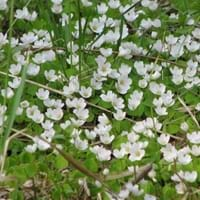Life Span
Perennial
Annual
Origin
World, Pandemic, North America, Europe, United Kingdom, Asia
South America, Micronesia, New Zealand
Types
Not available
Not Available
Habitat
Shaded sites, Woodlands
coastal environs, Grassland, Roadsides, Waste areas, waterways
USDA Hardiness Zone
3-8
7-11
Sunset Zone
A3, 1a, 1b, 2a, 2b, 3a, 3b, 4, 5, 6, 7, 8, 9, 10, 14, 15, 16, 17, 18, 19, 20, 21, 22, 23, 24
H1, 3a, 3b, 4, 5, 6, 7, 8, 9, 10, 11, 12, 13, 14, 15, 16, 17, 18, 19, 20, 21, 22, 23, 24
Habit
Mat-forming
Clump-Forming
Flower Color
White, Light Pink
Purple
Flower Color Modifier
Bicolor
Bicolor
Fruit Color
Not Available
Not Available
Leaf Color in Spring
Light Green
Green, Light Green, Dark Green
Leaf Color in Summer
Light Green
Light Green
Leaf Color in Fall
Light Green
Green, Light Green, Dark Green
Leaf Color in Winter
Light Green
Dark Green, Tan
Leaf Shape
Heart-shaped
Grass like
Plant Season
Spring, Summer, Fall
Spring, Summer, Fall, Winter
Sunlight
Partial Sun, Partial shade, Full Shade
Full Sun
Type of Soil
Clay, Loam, Sand
Loam
The pH of Soil
Neutral
Acidic, Neutral
Soil Drainage
Average
Well drained
Bloom Time
Spring
Summer, Fall
Tolerances
Shade areas
Drought, Salt
Where to Plant?
Ground
Ground
How to Plant?
Divison, Seedlings
Seedlings
Plant Maintenance
Low
Medium
Watering Requirements
Water in the early morning hours
Average Water Needs
In Summer
Lots of watering
Lots of watering
In Spring
Moderate
Moderate
In Winter
Average Water
Average Water
Soil pH
Neutral
Acidic, Neutral
Soil Type
Clay, Loam, Sand
Loam
Soil Drainage Capacity
Average
Well drained
Sun Exposure
Partial Sun, Partial shade, Full Shade
Full Sun
Pruning
Remove damaged leaves, Remove dead branches, Remove dead flowers, Remove dead leaves
Remove damaged leaves, Remove dead branches, Remove dead leaves
Fertilizers
All-Purpose Liquid Fertilizer
All-Purpose Liquid Fertilizer
Pests and Diseases
Aphids, Root rot, Whiteflies
Red blotch
Plant Tolerance
Shade areas
Drought
Flower Petal Number
Single
Single
Foliage Texture
Medium
Fine
Foliage Sheen
Matte
Matte
Invasive
Sometimes
Sometimes
Attracts
Insects
Not Available
Allergy
Asthma, Depression
Itchiness
Aesthetic Uses
Not Used For Aesthetic Purpose
Showy Purposes
Beauty Benefits
Good for skin, Not Available
Not Available
Edible Uses
Yes
Sometimes
Environmental Uses
Air purification
Air purification
Medicinal Uses
Digestive, Eye Problems, Vitamin A, Vitamin C
Not Available
Part of Plant Used
Flowers, Leaves
Flowers, Leaves
Other Uses
Cleanser
Animal Feed, Used as Ornamental plant
Used As Indoor Plant
No
No
Used As Outdoor Plant
Yes
Yes
Garden Design
Container, Mixed Border, Wildflower
Cutflower, Dried Flower/Everlasting, Feature Plant, Foundation, Groundcover, Mixed Border, Screening / Wind Break
Botanical Name
OXALIS acetosella
CORTADERIA jubata
Common Name
wood sorrel, common wood sorrel
Purple Pampas Grass
In Hindi
Wood Sorrel
Purple pampas grass
In German
Sauerklee
Lila Pampasgras
In French
bois Sorrel
Pourpre herbe de pampa
In Spanish
alazán de madera
hierba púrpura pampas
In Greek
ξύλο Sorrel
Μωβ γρασίδι παμπάς
In Portuguese
Sorrel de madeira
grama roxa pampas
In Polish
Drewno szczaw
Purpurowy trawa pampasów
In Latin
Rumex ligno
Purpura Pampas herba
Phylum
Magnoliophyta
Magnoliophyta
Class
Magnoliopsida
Liliopsida
Family
Oxalidaceae
Poaceae
Clade
Angiosperms, Eudicots, Rosids
Angiosperms, Commelinids, Monocots
Tribe
Not Available
Not Available
Subfamily
Not Available
Not Available
Number of Species
Not Available
Importance of Wood Sorrel and Purple Pampas Grass
Want to have the most appropriate plant for your garden? You might want to know the importance of Wood Sorrel and Purple Pampas Grass. Basically, these two plants vary in many aspects. Compare Wood Sorrel and Purple Pampas Grass as they differ in many characteristics such as their life, care, benefits, facts, etc. Every gardener must at least have the slightest clue about the plants he wants to plant in his garden. Compare their benefits, which differ in many ways like facts and uses. The medicinal use of Wood Sorrel is Digestive, Eye Problems, Vitamin A and Vitamin C whereas of Purple Pampas Grass is Not Available. Wood Sorrel has beauty benefits as follows: Good for skin and Not Available while Purple Pampas Grass has beauty benefits as follows: Good for skin and Not Available.
Compare Facts of Wood Sorrel vs Purple Pampas Grass
How to choose the best garden plant for your garden depending upon its facts? Here garden plant comparison will help you to solve this query. Compare the facts of Wood Sorrel vs Purple Pampas Grass and know which one to choose. As garden plants have benefits and other uses, allergy is also a major drawback of plants for some people. Allergic reactions of Wood Sorrel are Asthma and Depression whereas of Purple Pampas Grass have Itchiness respectively. Having a fruit bearing plant in your garden can be a plus point of your garden. Wood Sorrel has no showy fruits and Purple Pampas Grass has showy fruits. Also Wood Sorrel is flowering and Purple Pampas Grass is not flowering . You can compare Wood Sorrel and Purple Pampas Grass facts and facts of other plants too.





